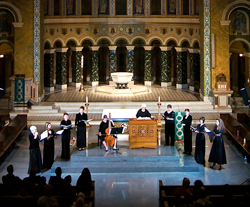by Nicholas Jones

The occasion was one event in celebration of the church’s magnificent new tracker organ, modeled on north German 17th-century organs. The organ was built by the Tennessee firm of Richards, Fowkes and Company and installed only this January. It replaces a small gallery organ in the back of the church. A stop-action video documenting the organ’s installation is online at YouTube.
The organ is still being adjusted, but from what I heard, it has a lively delicacy that suits both early solo music and the accompaniment of singers. Boston-based organist Frances Fitch played it to great effect. Oberlin’s James Christie will perform a dedicatory recital on Sunday afternoon, May 12, where no doubt the full range of the organ will be revealed.
The singers were the esteemed Newberry Consort, based in Chicago and directed by the excellent early music vocalist and CWRU faculty member Ellen Hargis. In this concert, eight accomplished singers — many of them Clevelanders — took on the roles of nuns from the Renaissance, singing music that would have been heard in convents in Italy and Mexico in the 16th and 17th centuries. (Pictured above: Celestial Sirens as performed in Chicago).
In the first half the group highlighted two big Italian motets for eight voices, performed with organ and viola da gamba accompaniment. The all-woman choir created a full, rich, and unusual sound, several of the mezzos diving deep into the baritone range to support their treble colleagues.
Especially delicious was a trio by the Vicenzan composer Leone Leoni. It was set in the lower register of the women’s voices, which made the most of the liquid metaphor of the Song of Solomon text, “Anima mea liquefacta est” — “my soul melted when my beloved spoke.” Quite a text for a convent!
Interspersed among the vocal numbers throughout the concert were organ solos, which Ms. Fitch played with elegance and variety. Particularly wonderful was a jazzy villancico (a kind of carol) by Gaspar Fernandez, which she registered entirely on a clear high stop. In another interlude, gambist Katherine Shuldiner took the lead in a virtuosic set of variations by Angelo Notari, a Paduan who spent much of his life in England. Oddly, the theme on which this sober and introspective piece was based is a satiric song, “La Monaca,” about a nun who didn’t want to be a nun.
The organ pieces in the first half, several of them by members of the Gabrieli family, were earlier in period and more conservative in style than a number of the vocal compositions, in which the “modern” expressivity of the Baroque was evident.
Especially beautiful among the vocal pieces was “O superbi mundi machine,” a rich meditation on the vanity of the world by the late 17th-century Ursuline nun Maria Xaviera Perucona. The text has that unabashedly metaphoric eclecticism of Marvell and Crashaw: “Our life is like a flower in which death alone reigns; a sighing breath is an ash which fades away like the dew.”
The second half of the concert featured music from a remarkable collection at the Newberry Library at the University of Chicago, the six choirbooks of the Mexico City convent of Nuestra Señora de la Encarnación. From these 17th-century choirbooks, the consort sang four rich motets for eight voices, making it clear that life as a nun did not necessarily mean musical asceticism, whatever other forms of abstinence it did involve.
In the first of these, a Magnificat by one Fabián Peréz Ximeno, the otherwise secure vocal ensemble of the consort did not quite cohere. But in other pieces, the singers showed good rhythmic coordination and admirable accuracy of pitch (tuning to the organ in “temperament-modified meantone” must not have been easy).
The Church of the Covenant may have to make some adjustments in how to use the reconfigured space around the organ. The narrow gallery in which the singers were spread out does not allow for as much visual contact amongst them as would be found on a larger stage, though the Newberry singers coped well.
More seriously, the singers stand some four or five feet below the floor on which the organ is built. Thus, they are significantly lower than the organist, who had to turn around and look down to catch the beginnings and ends of phrases, with some inevitable lapses in ensemble at the cadences. There seems to be no mirror or video camera installed as yet to help with visual cueing. These issues will no doubt get worked out before long.
The audience, on a snowy night in midweek, was small but appreciative. At the end, after warm applause, the singers generously gave an encore performance of the first choral piece of the evening, an expressive “Cantabant sancti” by Giovanni Battista Cesena.
Nicholas Jones is Professor of English at Oberlin and a keen amateur musician.
Published on ClevelandClassical.com March 25, 2013
Click here for a printable version of this article.



